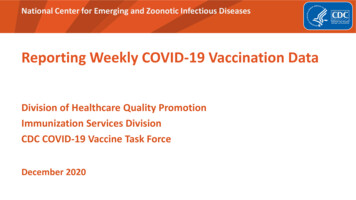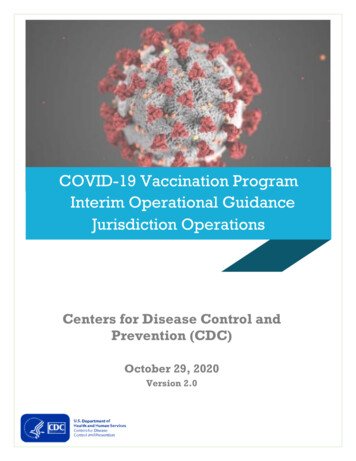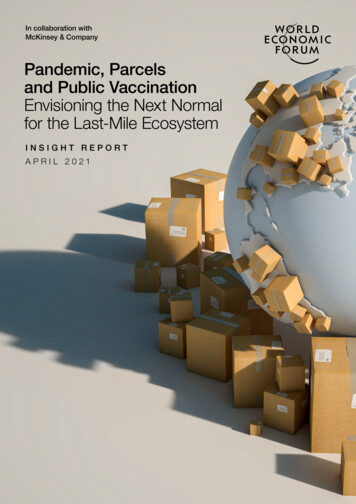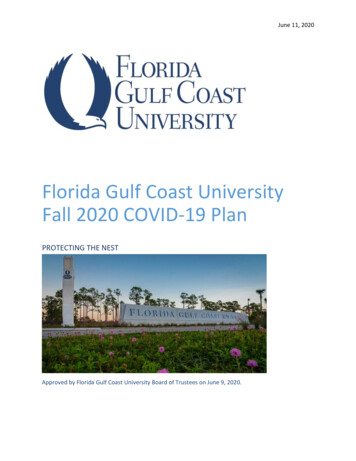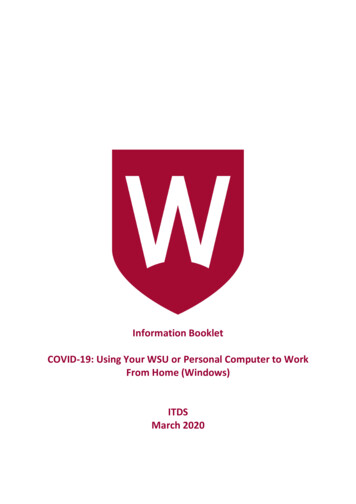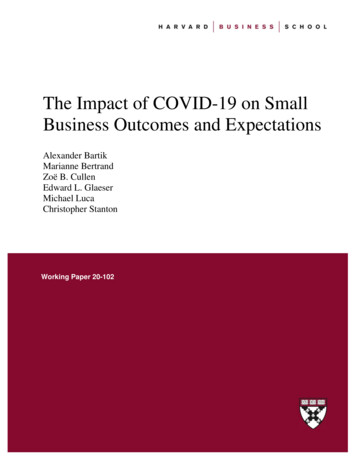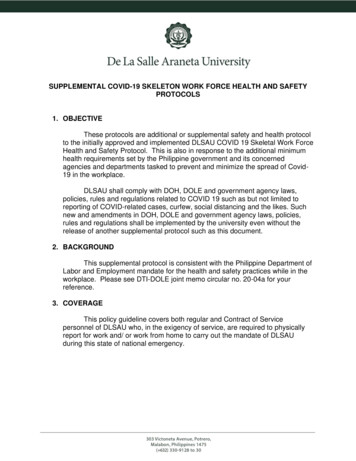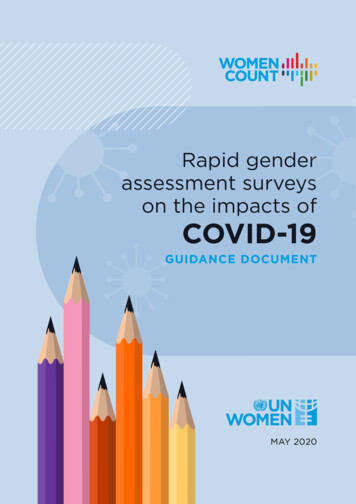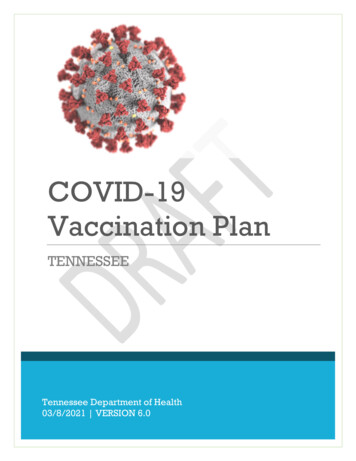
Transcription
COVID-19Vaccination PlanTENNESSEETennessee Department of Health03/8/2021 VERSION 6.0
Table of ContentsRecord of Changes . 3Section 1: COVID-19 Vaccination Preparedness Planning . 5Section 2: COVID-19 Organizational Structure and Partner Involvement . 8Section 3: Phased Approach to COVID-19 Vaccination .11Section 4: Critical Populations .22Section 5: COVID-19 Provider Recruitment and Enrollment .24Section 6: COVID-19 Vaccine Administration Capacity .27Section 7: COVID-19 Vaccine Allocation, Ordering, Distribution, and Inventory Management .28Section 8: COVID-19 Vaccine Storage and Handling .32Section 9: COVID-19 Vaccine Administration Documentation and Reporting .34Section 10: COVID-19 Vaccination Second-Dose Reminders .40Section 11: COVID-19 Requirements for IISs or Other External Systems .41Section 12: COVID-19 Vaccination Program Communication .45Section 13: Regulatory Considerations for COVID-19 Vaccination .47Section 14: COVID-19 Vaccine Safety Monitoring .47Section 15: COVID-19 Vaccination Program Monitoring .48Appendix .552
Record of ChangesDate of original version: e 03/08/2021Description of ChangeUpdates to prioritization to reflect ACIPrecommendations issued 12/1/2020.Updates to VOMS reconciliation anddashboarding.Updates to prioritization to reflect ACIPrecommendations issued 12/20/2020.Updates to distribution strategy.Updates to prioritization and allocationstrategy.Updates to reflect CDC/WHO guidancefor pregnant women. Clarifications ofphase populations and updates toallocation strategy.Updates to Phase 1c based on CDCguidance. Various other clarifications.Addition of Janssen vaccine informationName ofAuthorMFiscusMFiscusMFiscusMFiscusMFiscus3
4
Section 1: COVID-19 Vaccination Preparedness PlanningA. Describe your early COVID-19 vaccination program planning activities, including lessonslearned and improvements made from the 2009 H1N1 vaccination campaign, seasonalinfluenza campaigns, and other responses to identify gaps in preparedness.a. The TDH Communicable and Environmental Disease and Emergency Preparedness(CEDEP) division served as lead for the 2009 H1N1 Influenza Pandemic Outbreakresponse in Tennessee. TDH CEDEP response activities included establishing commandand control, defining communication pathways, refining surveillance and epidemiology,revisiting fatality management, expanding laboratory services, coordination of massvaccination clinics through local, regional, and metropolitan health departments, hiringof temporary staff, vaccine distribution, tracking doses administered, warehousing anddistribution of medical countermeasures, deployment of personal protective equipment(PPE), processing contracts (including the state’s influenza call center and provision ofimmunization services to agencies targeting underserved populations), anddevelopment of mass media messaging and guidance. There were lessons learned andbest practices identified from this response that generated numerous opportunities forTDH staff to deliver abstracts, posters, presentations, and articles. Early vaccineplanning activities and lessons learned included: Engaging federal officials from CDC, HHS ASPR, and other Region IV states in agap analysis discussion pertaining to where the federal response ends and thestate and local response begins. Identification of ancillary supplies (needles, syringes, sharps containers, etc.)needed to mount a massive vaccination response as was most recentlyexperienced through our multi-year statewide response to hepatitis A and 2009H1N1 response. Identification of both fixed and mobile cold chain capacity (vaccine refrigerators,mobile coolers, fridge freeze units, temperature data loggers, etc.) to storevaccine both centrally and allow for mobile vaccination operations in thecommunity as was most recently experienced through our multi-year statewideresponse to hepatitis A and 2009 H1N1 response. Identification of external stakeholders with vaccination response expertise tobest inform resource allocation decisions and public messaging strategies. Identification of surge contract staffing needs for almost every aspect of thevaccination response including clerical, administrative, clinical, epidemiology,and information technology as was most recently experienced through ourmulti-year statewide response to hepatitis A and 2009 H1N1 response. Identification of essential elements of information and response metrics thatwill be needed to inform the public and local, state, and federal leadership on aregular basis through situation reporting, data visualization, and dashboarding.5
Identification of immunization information system enhancements and a multitier cohort of knowledgeable staff that can operate all aspects of vaccinesystems response from provider enrollment, validation, vaccine allocation,reporting, and technical assistance. Conduct outreach to vulnerable populations through non-profit entities andupdate GIS mapping of known vulnerable populations to target vaccineinterventions. Identification of proactive administrative preparedness steps and removal ofbarriers that can be taken to expedite procurement, contracting, and allocationof grant dollars to sub-recipients.b. The TDH Vaccine-Preventable Diseases and Immunization Program (VPDIP) workedclosely with the Emergency Preparedness Program to respond to the hepatitis Aoutbreak from December 2017-May 2020, involving more than 3,000 cases. Experiencegained and gaps identified included: TDH Incident Command System was activated and provided a sustained,coordinated response for 18 months. Local health departments were tasked to complete case interviews, performcontact tracing and monitoring, and provide individual and publiccommunications and needed to reassign duties to meet the demands of thatoutbreak response. Vaccination strike teams were deployed across the state to reach vulnerablepopulations at risk of contracting and spreading the virus. More than 23,000doses of hepatitis A vaccine were provided by six strike teams and nearly233,000 doses were administered by private and public health providers inmedical offices, health departments, jails, prisons, drug rehabilitation centers,medically-assisted opioid treatment programs, homeless shelters andencampments, and other locations where those not routinely seekinghealthcare could be reached. These strike teams proved to be a best practice forthe successful administration of vaccines to at-risk populations. Challenges included individual concerns regarding the vaccine itself and mistrustof the government, the hiring and supervision of large numbers of contractedworkers, coordination of efforts and communication with metro jurisdictionsthat are not under the umbrella of TDH, and the need for sustained publiccommunication around this prolonged outbreak.B. Include the number/dates of and qualitative information on planned workshops ortabletop, functional, or full-scale exercises that will be held prior to COVID-19 vaccineavailability. Explain how continuous quality improvement occurs/will occur during theexercises and implementation of the COVID-19 Vaccination Program.a. With the support of executive leadership in 2018 the Tennessee Department of Healthinitiated a statewide pandemic preparedness vaccination effort known as Fight Flu TN.The goal of the effort was to empower each of our 95 counties to build robust andtrusted community partnerships, vaccination plans, trained staff, and ability to operateautonomously in the face of worldwide pandemic. This was coupled with the interest of6
improving vaccination rates and the need to innovate vaccination administrationstrategies. On Dec. 5, 2018, TDH stood up 115 Points of Dispensing (PODs), 113 that wereopen to the public (of those 84 were walk-through on site, 21 walk-through offsite, and 8 drive through) and 2 closed PODs for special populations and a totalof nearly 4,500 vaccines were administered in one day across the 95 counties.In total over 1,200 staff were involved in the response efforts which includednot only the vaccination PODs but also 14 Health Emergency Operations Centersat the state and local level. Statewide after action reporting and improvementplans were developed with continuous quality improvement in mind. On Nov. 19, 2019, TDH increased the number of simultaneously opened PODsfrom 115 to 175, including 156 open PODs (of those 56 were walk-through onsite, 75 walk-through off site, and 25 drive through) and 19 closed PODs forspecial populations (of those 15 were for vulnerable populations and 4 for firstresponders), and the number of administered doses of flu vaccine doubled to9,666. Statewide after action reporting and improvement plans were developedwith continuous quality improvement in mind. Additionally, vaccinesadministered during Fight Flu TN were recorded manually into TennIIS(Tennessee Immunization Information System) after the conclusion of theevent. On Nov. 19, 2020, TDH activated its public health infrastructure in all 95counties to Fight Flu TN. All local health departments developed plans thatwere tailored to accommodate the realities of our current COVID-19 response.In addition, community healthcare partners, universities, and others wereengaged in this one-day preparedness event that furthered our movementtoward COVID-19 vaccine preparedness. This year’s exercise also incorporatedreal-time reporting of administered doses of vaccine into TennIIS through a newMass Immunizations Module, which allows for the rapid entering of vaccineadministration data during mass immunization events. In collaboration with the Tennessee Emergency Management Agency (TEMA),TDH created a series of webinar-based vaccination table-top exercises whichwere conducted November 9, 10, and 12 in partnership with our EmergencyPreparedness and Response Healthcare Coalitions (HCCs). The objectives of theexercises included vaccine assumptions, logistics, administration, and reportingand these exercises were used to educate those involved with vaccinatingindividuals through hospitals, employee health, and other partneringorganizations. Tabletop exercises were conducted with Community Health Services week ofNovember 16, 2020. Tabletop exercises have been conducted weekly with the UCG and variousstakeholders including Commissioners, National Guard and State Highway Patrolleadership, the Governor’s Communications Team, TDH leadership and others.These exercises began November 20, 2020 and have continued weekly untilvaccines arrived in the state to ensure Tennessee is prepared for any scenario.7
Once vaccines were deployed, these exercises transitioned to bi-weekly “hotwash” meetings to determine successes and opportunities for improvement, aswell as anticipate future challenges.Tabletop exercises with TN Department of Correction, began December 22,2020.The Tennessee Hospital Association began participating in UCG tabletopexercises in December 2020.Section 2: COVID-19 Organizational Structure and Partner InvolvementA. Describe your organizational structure.The Tennessee Department of Health is led by Dr. Lisa Piercey, Commissioner of Health,who reports directly to Governor Bill Lee. The TDH Executive Leadership Team consists ofthe Chief of Staff, the State Chief Medical Officer, Deputy Commissioner for PopulationHealth, and the Deputy Commissioner for Operations.8
B. Describe how your jurisdiction will plan for, develop, and assemble an internal COVID-19Vaccination Program planning and coordination team that includes persons with a widearray of expertise as well as backup representatives to ensure coverage.The initial TDH COVID-19 Vaccination Program Planning Team included members of theVaccine-Preventable Diseases and Immunization Program team and the Office of EmergencyPreparedness. Two of the representatives were with state departments of health during the2009 H1N1 pandemic. This team began meeting in late June 2020. In late July 2020,leadership of Community Health Services, which oversees the 89 rural health departments,was added, as well as a representative of our overall COVID-19 EP Response team and theTDH Office of Communications and Media Relations. There is enough redundancy ofexpertise within the planning and coordination team to ensure coverage in the event of alead member’s inability to continue in their role.C. Describe how your jurisdiction will plan for, develop, and assemble a broader committeeof key internal leaders and external partners to assist with implementing the program,reaching critical populations, and developing crisis and risk communication messaging.TDH has convened a Pandemic Vaccine Planning Stakeholder group which meets every twoweeks and is leveraged to help inform allocation decisions, define priority populations, andidentify gaps in knowledge. The group is comprised of more than 30 different offices,agencies, and departments representing public health, rural health, refugee and otherminority populations, legislators, experts in bioethics, medical societies, communicationsexperts, health care coalitions, emergency management, and others. This group is also usedto vet crisis and risk communication messages. In addition, the Unified Command Group9
(UCG) and the Governor’s office are highly engaged in any public communications ormessaging campaigns addressing vaccinations. TDH’s Office of Minority Health andDisparities Elimination (OMHDE) has conducted open weekly virtual stakeholder meetingssince May 2020. The State Plan has been presented multiple times since November 2020and OMHDE has a representative on the stakeholder group.D. Describe how your jurisdiction will coordinate efforts between state, local, and territorialauthorities.Tennessee is a hybrid state where 89 of its 95 counties report to the State and six metrosare independent from the State. Tennessee contracts with these six counties (Shelby,Madison, Davidson, Sullivan, Knox, and Hamilton) to conduct public health activities.Tennessee does not have territorial authorities. Statewide efforts are coordinated throughmultiple agencies involved with the State’s overall pandemic response and communicatedthrough agency leadership, the Unified Command Group (UCG), and the Governor’s office.Coordination between the State and local authorities occurs through numerous channels,including partnering agencies, medical societies, health care coalitions, and emergencymanagement agencies, in addition to multiple opportunities for partners to participate incalls and webinars (bi-weekly COVID-19 update webinar for clinicians, bi-weekly callsbetween TDH and metro, regional and local health departments; monthly calls withTennessee Hospital Association, long term care facilities, and others; frequent pressconferences that include the Commissioner of Health, and others).E. Describe how your jurisdiction will engage and coordinate efforts with leadership fromtribal communities, tribal health organizations, and urban Indian organizations.Tennessee does not have federally-recognized tribal communities.F. List key partners for critical populations that you plan to engage and briefly describe howyou plan to engage them, including but not limited to: PharmaciesCorrectional facilities/vendorsHomeless sheltersCommunity-based organizations, including charitable care clinics and FederallyQualified Health Centers (FQHCs)10
Critical populations are engaged through the following partners, largely through our StakeholderGroup and professional societies. These include the following:a. Pharmacies—through our partnership with TN Pharmacists’ Association have engagedpharmacies, especially those in rural areas, to complete the CDC Provider Agreementand Profile and onboarding process to become pandemic vaccine providers in theircommunities. These pharmacies assist with vaccination of residents of long-term carefacilities that opt out of the federal partnership with Walgreens and CVS, vaccination ofhigh-risk populations, and public vaccination efforts.b. Correctional facilities—through our partnership within the Stakeholder Group, TNDepartment of Correction and the TN Sheriffs’ Association are part of the planningprocess for vaccine allocations and distribution to ensure the population housed incorrectional facilities is included in planning. Prison intake facilities are onboarding toprovide COVID-19 vaccine as they have similarly done with hepatitis A vaccine, as well asto vaccinate their first responder population and health care workers. Additionally,vaccination strike teams will be scheduled to visit jails and other congregate carefacilities to ensure these populations are provided the opportunity to receive vaccine.During the hepatitis A outbreak, strike teams delivered hepatitis A vaccine in all countyjails across the state at least once, if not on a recurring basis. We will leverage thismodel and the relationships built by local public health to implement the samevaccination outreach.c. Homeless shelters—through our partnership with the TDH Office of DisparitiesElimination, strike teams will be scheduled to visit locations where individualsexperiencing homelessness gather. During the hepatitis A outbreak, strike teamsprioritized homeless shelters as one of the target sites for providing vaccine outreach.We will leverage the relationships built by our local public health during this response.d. Community-based organizations—through our multiple partner agencies, communityhealth centers, federally-qualified health centers, hospitals, home health agencies, K-12schools, institutes of higher education, large corporations, urgent visit clinics, andprivate medical providers are being onboarded as pandemic vaccine providers.Section 3: Phased Approach to COVID-19 VaccinationA. Describe how your jurisdiction will structure the COVID-19 Vaccination Program around thethree phases of vaccine administration:Phase 1: Potentially Limited Doses AvailablePhase 2: Large Number of Doses Available, Supply Likely to Meet DemandPhase 3: Likely Sufficient Supply, Slowing DemandAfter careful review of the CDC Playbook, the National Academies’ of Sciences, Engineering andMedicine’s Framework for Equitable Allocation of COVID-19 Vaccine, the recommendations of11
the Advisory Committee on Immunization Practices (ACIP), and discussion with the StakeholderGroup, TDH leadership, and the Unified Command Group, the following structure has beenadopted for the allocation and prioritization of COVID-19 vaccines: Pfizer vac
5 Section 1: COVID-19 Vaccination Preparedness Planning A. Describe your early COVID-19 vaccination program planning activities, including lessons learned and improvements made from the 2009 H1N1
